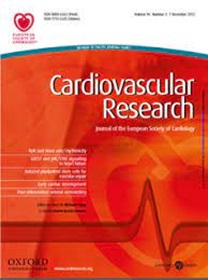脂蛋白升高人群的血管再生缺陷(a): Lp(a)-VRCE CardioLink-16转化研究
IF 13.3
1区 医学
Q1 CARDIAC & CARDIOVASCULAR SYSTEMS
引用次数: 0
摘要
目的脂蛋白(a) [Lp(a)]是动脉粥样硬化性心血管疾病(ASCVD)的因果危险因素;然而,Lp(a)与血管修复能力之间的关系尚不清楚。血管再生(VR)祖细胞的耗竭已被证明是心血管代谢疾病患者血管修复受损的新指标。本研究的目的是确定Lp(a)水平升高是否会改变VR细胞内容物的特性。方法和结果横断面、多位点脂蛋白(a)和血管再生细胞含量CardioLink-16 [Lp(a)-VRCE]研究纳入40人,其中20人Lp(a)≥100 nmol/L, 20人Lp(a) <;100 nmol / L。采用多参数流式细胞术对分离的外周血单个核细胞进行分析。VR祖细胞是基于高醛脱氢酶(ALDH)活性,结合原始和成熟谱系特异性细胞表面标记进行鉴定的。Lp(a)≥100 nmol/L组与Lp(a) <;100 nmol/L组如较低的肾小球滤过率(86.9 vs 100.1 mL/min/1.73 m2),较低的总胆固醇(4.0 vs 4.8 mmol/L),更多的他汀类药物使用(90% vs 60%), ASCVD患病率较高(60% vs 25%)。Lp(a)≥100 nmol/L组促血管生成的ALDHhiSSClowCD133+ (P = 0.0008)和ALDHhiSSClowCD34+CD133+ (P = 0.005)祖细胞具有促血管生成功能的频率较低。与Lp(a) <;100 nmol/L组,Lp(a)≥100 nmol/L组个体在参与血管修复的m1极化促炎单核细胞(ALDHhiSSCmidCD86+CD163−;P = 0.007)和ALDHhiSSChiCD49d+粒细胞前体细胞的频率较低(P = 0.04)。在这项转化研究中,Lp(a)≥100 nmol/L的人比Lp(a)水平的人有更少的VR细胞和更多的促炎极化单核细胞前体细胞。100 nmol / L。这些发现表明,Lp(a)水平升高的个体的血管修复活动可能受到损害。注册Lp(a)-VRCE ClinicalTrials.gov: NCT06626659本文章由计算机程序翻译,如有差异,请以英文原文为准。
Vascular regenerative deficiencies in people with elevated lipoprotein(a): the Lp(a)-VRCE CardioLink-16 translational study
Aims Lipoprotein(a) [Lp(a)] is a causal risk factor for atherosclerotic cardiovascular disease (ASCVD); however, the relationship between Lp(a) and the capacity for vascular repair remains unclear. Depletion of vascular regenerative (VR) progenitor cells has been shown to be a novel indicator of compromised vascular repair in people living with cardiometabolic disorders. The purpose of this study was to determine if elevated levels of Lp(a) modify VR cell content properties. Methods and results The cross-sectional, multi-site Lipoprotein(a) and Vascular Regenerative Cell Content CardioLink-16 [Lp(a)-VRCE] study enrolled 40 individuals—20 with Lp(a) ≥100 nmol/L and 20 with Lp(a) <100 nmol/L. Isolated peripheral blood mononuclear cells were analysed by multi-parameter flow cytometry. VR progenitor cells were identified based on high aldehyde dehydrogenase (ALDH) activity, in combination with primitive vs. mature lineage-specific cell surface markers. The Lp(a) ≥100 nmol/L group exhibited baseline characteristic differences compared with the Lp(a) <100 nmol/L group such as lower estimated glomerular filtration rate (86.9 vs. 100.1 mL/min/1.73 m2), lower total cholesterol (4.0 vs. 4.8 mmol/L), greater statin use (90 vs. 60%), and a higher prevalence of ASCVD (60 vs. 25%). The Lp(a) ≥100 nmol/L group had lower frequencies of pro-angiogenic ALDHhiSSClowCD133+ (P = 0.0008) and ALDHhiSSClowCD34+CD133+ (P = 0.005) progenitor cells with pro-angiogenic secretory function. Compared with those in the Lp(a) <100 nmol/L group, individuals in the Lp(a) ≥100 nmol/L group demonstrated a higher frequency of M1-polarized pro-inflammatory monocytes (ALDHhiSSCmidCD86+CD163−; P = 0.007) and a lower frequency of ALDHhiSSChiCD49d+ granulocyte precursor cells (P = 0.04) that are involved in vessel repair. Conclusion In this translational study, people with an Lp(a) ≥100 nmol/L had fewer VR cells and more pro-inflammatory polarized monocyte precursor cells than those with Lp(a) levels <100 nmol/L. These findings suggest that vessel repair activities may be compromised in individuals with elevated Lp(a) levels. Registration Lp(a)-VRCE ClinicalTrials.gov: NCT06626659
求助全文
通过发布文献求助,成功后即可免费获取论文全文。
去求助
来源期刊

Cardiovascular Research
医学-心血管系统
CiteScore
21.50
自引率
3.70%
发文量
547
审稿时长
1 months
期刊介绍:
Cardiovascular Research
Journal Overview:
International journal of the European Society of Cardiology
Focuses on basic and translational research in cardiology and cardiovascular biology
Aims to enhance insight into cardiovascular disease mechanisms and innovation prospects
Submission Criteria:
Welcomes papers covering molecular, sub-cellular, cellular, organ, and organism levels
Accepts clinical proof-of-concept and translational studies
Manuscripts expected to provide significant contribution to cardiovascular biology and diseases
 求助内容:
求助内容: 应助结果提醒方式:
应助结果提醒方式:


